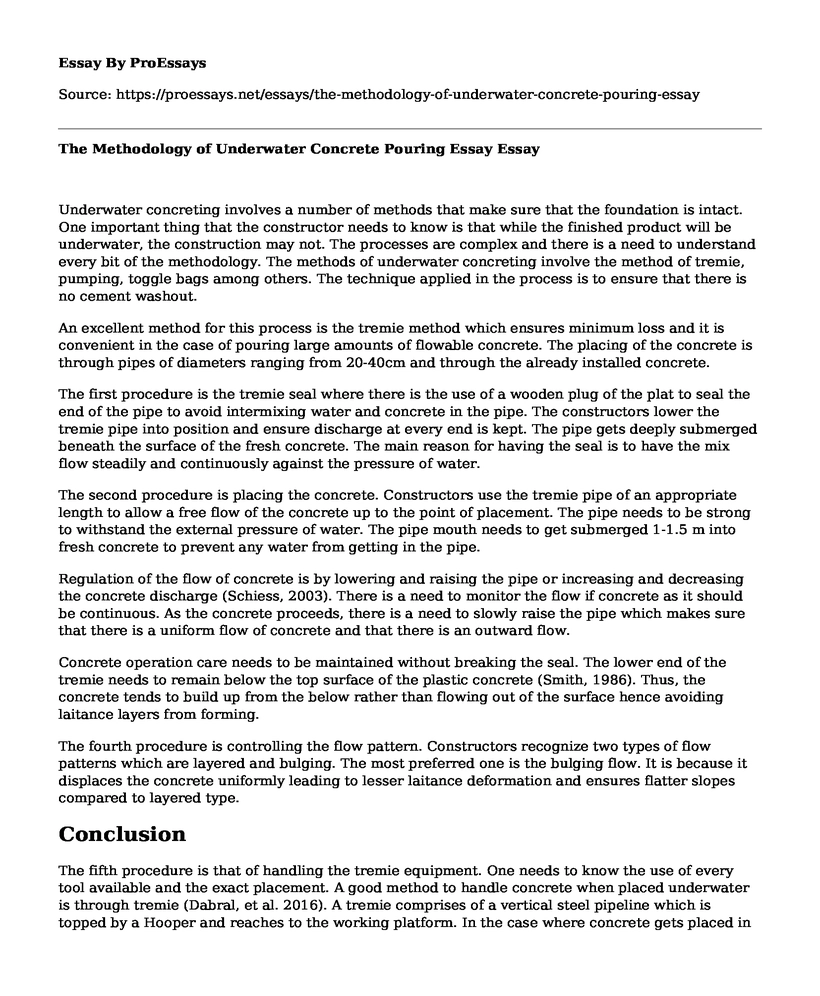Underwater concreting involves a number of methods that make sure that the foundation is intact. One important thing that the constructor needs to know is that while the finished product will be underwater, the construction may not. The processes are complex and there is a need to understand every bit of the methodology. The methods of underwater concreting involve the method of tremie, pumping, toggle bags among others. The technique applied in the process is to ensure that there is no cement washout.
An excellent method for this process is the tremie method which ensures minimum loss and it is convenient in the case of pouring large amounts of flowable concrete. The placing of the concrete is through pipes of diameters ranging from 20-40cm and through the already installed concrete.
The first procedure is the tremie seal where there is the use of a wooden plug of the plat to seal the end of the pipe to avoid intermixing water and concrete in the pipe. The constructors lower the tremie pipe into position and ensure discharge at every end is kept. The pipe gets deeply submerged beneath the surface of the fresh concrete. The main reason for having the seal is to have the mix flow steadily and continuously against the pressure of water.
The second procedure is placing the concrete. Constructors use the tremie pipe of an appropriate length to allow a free flow of the concrete up to the point of placement. The pipe needs to be strong to withstand the external pressure of water. The pipe mouth needs to get submerged 1-1.5 m into fresh concrete to prevent any water from getting in the pipe.
Regulation of the flow of concrete is by lowering and raising the pipe or increasing and decreasing the concrete discharge (Schiess, 2003). There is a need to monitor the flow if concrete as it should be continuous. As the concrete proceeds, there is a need to slowly raise the pipe which makes sure that there is a uniform flow of concrete and that there is an outward flow.
Concrete operation care needs to be maintained without breaking the seal. The lower end of the tremie needs to remain below the top surface of the plastic concrete (Smith, 1986). Thus, the concrete tends to build up from the below rather than flowing out of the surface hence avoiding laitance layers from forming.
The fourth procedure is controlling the flow pattern. Constructors recognize two types of flow patterns which are layered and bulging. The most preferred one is the bulging flow. It is because it displaces the concrete uniformly leading to lesser laitance deformation and ensures flatter slopes compared to layered type.
Conclusion
The fifth procedure is that of handling the tremie equipment. One needs to know the use of every tool available and the exact placement. A good method to handle concrete when placed underwater is through tremie (Dabral, et al. 2016). A tremie comprises of a vertical steel pipeline which is topped by a Hooper and reaches to the working platform. In the case where concrete gets placed in large quantities, it is crucial that one paces the concrete simultaneously and uniformly through the tremie pipes. This is better than choosing to sift a single pipe from one point. One can minimize the risk of segregation through ensuring maintenance of the concrete surface.
Works cited
Dabral, Kiran, R Selvaraj, Simon J. "Principles and Experimental Methods for Underwater Concrete Formulation." IOSR Journal of Mechanical and Civil Engineering (2016): 31-34. Web.
P, Smith. "Underwater Nondestructive Testing of Concrete: An Evaluation of Techniques." Naval Civil Engineering Laboratory. February 1986. 4, 7, 10.
Schiess, Peter. "Environmental effects of concrete." Fib State-of-art report (2003): 62. Web. Underwater Concrete. n.d. Web. 24 November 2018.
Cite this page
The Methodology of Underwater Concrete Pouring Essay. (2022, Oct 25). Retrieved from https://proessays.net/essays/the-methodology-of-underwater-concrete-pouring-essay
If you are the original author of this essay and no longer wish to have it published on the ProEssays website, please click below to request its removal:
- Overview of Available Techniques for Recovery in Oil Production
- Compare and Contrast Essay on Special Service Contract and Concession Contract
- Fair Value Measurement in the Oil and Gas Industry Essay
- Paper Example on Design Parameters and Soil Tests
- Summary for Engineering Economics Paper Example
- Essay Example on Nuclear Energy: Advantages & Disadvantages in Engineering
- Aspects of Electrical Engineering Career: Paper Example







